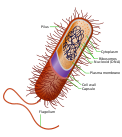Cell physiology
Their mechanisms are simpler than later-evolved eukaryotes, which contain a nucleus that envelops the cell's DNA and some organelles.Both have plasma membranes and ribosomes (structures that synthesize proteins[clarification needed] and float free in cytoplasm).Two unique characteristics of prokaryotes are fimbriae (finger-like projections on the surface of a cell) and flagella (threadlike structures that aid movement).The nucleus, the feature of a eukaryote that distinguishes it from a prokaryote, contains a nuclear envelope, nucleolus and chromatin.In cytoplasm, endoplasmic reticulum (ER) synthesizes[clarification needed] membranes and performs other metabolic activities.The Golgi apparatus consists of multiple membranous sacs, responsible for manufacturing and shipping out materials such as proteins.[3] Endocytosis is a form of active transport where a cell takes in molecules, using the plasma membrane, and packages them into vesicles.



physiologyorganismAnimal cellsplant cellsmicroorganismprokaryoteseukaryotesnucleusorganellesmembranebacteriaarchaeaplasmaribosomescytoplasmfimbriaeflagellanuclear envelopenucleoluschromatinendoplasmic reticulummetabolicGolgi apparatusproteinsLysosomesenzymesphagocytosisendocytosisexocytosismitochondriacellular respirationcytoskeletonfiberscell membranepassive transportactive transportadenosine triphosphateLipidscarbohydratesglycoproteinsglycolipidsvesiclesplasma membranesecretory proteinselectrochemical gradientsodiumpotassiumadenosine diphosphatemoleculespseudopodsvacuolehydrolyticOpenStaxReece, Jane B.Medical College of GeorgiaMedical Subject HeadingsCell signalingSignal transductionTGF betaMAPK/ERKJAK-STATAkt/PKBFas apoptosisPI3K/AKT/mTOR pathwayReceptor ligandsHormonesNeurotransmittersNeuropeptidesNeurohormonesCytokinesGrowth factorsSignaling moleculesReceptorsCell surfaceIntracellularCo-receptorSecond messengercAMP-dependent pathwayCa2+ signalingLipid signalingSignal transducing adaptor proteinScaffold proteinTranscription factorsGeneralTranscription preinitiation complexJuxtacrineAutocrineParacrineEndocrineIntracrine actionSynaptic transmissionChemical synapseNeuroendocrine signalingExocrine signallingPheromonesMechanotransductionPhototransductionIon channel gatingGap junctionFish physiologyHuman physiologyInsect physiologyPhysiology of dinosaursPlant physiologyPlant perception (physiology)Physiological plant disordersComparative physiologyEcophysiologyElectrophysiologyEvolutionary physiologyMolecular physiologyNeurophysiology